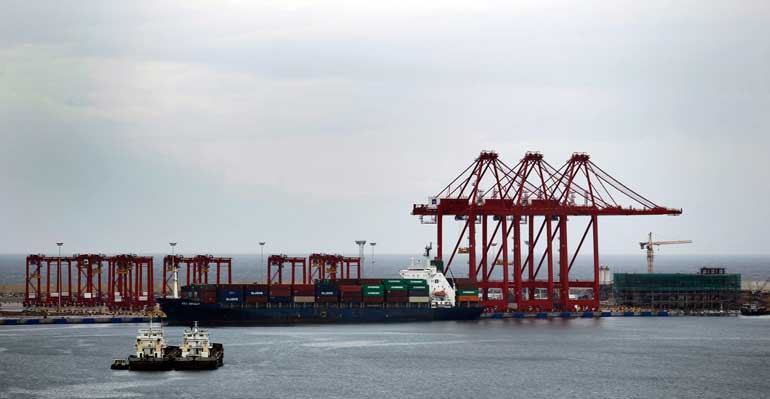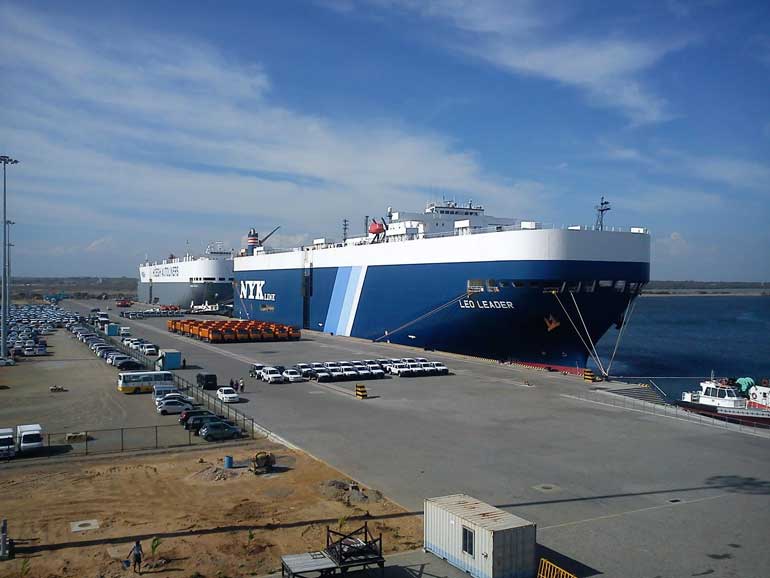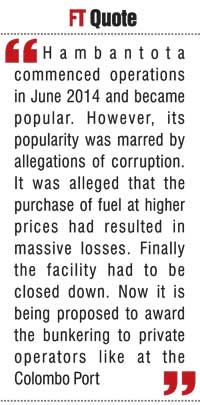Friday Apr 11, 2025
Friday Apr 11, 2025
Monday, 10 August 2015 00:00 - - {{hitsCtrl.values.hits}}

Colombo port South Terminal

Hambantota Port
The filling of the basin of the controversial Hambantota Harbour with seawater began on 12 July with a simple ceremony attended by Ports and Shipping Minister Arjuna Ranathunga.
The previous ceremony, led by former President Mahinda Rajapaksa, was a costly affair with much fanfare, but it failed to yield any positive results and has been subjected to much criticism.
History
Around 250 BC, in the Kingdom of Ruhuna, the inland harbour on Walawe River and the bay of Godavaya in Ambalantota were seaports used by Chinese and Arabian merchants, a part of the maritime silk route.
Furthermore, the Port of Colombo was known to Roman, Arab and Chinese traders for over 2,000 years. During the 8th century, Arab traders settled in Colombo, using it as a base for their trading activities. When the Portuguese arrived in Sri Lanka in 1505, they discovered the Port of Colombo and made a treaty with the King of Kotte, giving them the right to trade cinnamon while giving him authority over the coastline. They expelled Muslim traders and began building a fort in 1517.
During the 1980s, containerisation of cargo at the Colombo port underwent rapid modernisation with the installation of gantry cranes and the port being dredged to a depth of 15 metres. Colombo became one of the biggest artificial harbors in the region. But within a decade, shipping lines employing mega carriers concentrated on transshipment between major ports; small container ships handled shipping between smaller and major ports. Sri Lanka’s ports needed to improve their facilities to accommodate the expanding transshipment cargo or lose to other ports that were developing.
A harbour in Hambantota
During early 1990s under President Chandrika Kumaratunga, with Mahinda Rajapaksa serving as Minister of Fisheries and being in charge of the Sri Lanka Ports Authority, a proposal was made to establish a new port in Hambantota. The proposed location is only six to ten nautical miles (19 km) from one of world’s busiest shipping routes, between the Malacca Straits and the Suez Canal linking Asia and Europe. An estimated 36,000 ships, including 4,500 oil tankers use the route annually.
The Port of Colombo is over half a day away. The proposed port was expected to supply services including refueling, maintenance, logistics, offer provisions and medical supplies and relieve pressure on the Colombo Port.
Among the most vocal promoters of the new harbor was Ariyaseela Wickramanayake, who originated from the South and was the Chairman of the engineering firm Master Divers and prepared maps, plans, charts and even held a workshop in Colombo.
The most important feature of the proposal was the location of the harbor in Karagam Lewaya, an abandoned saltern, within the land mass.
Salterns in Sri Lanka
Every schoolchild is aware that salt is produced in a saltern but our way of producing salt is confined to a very few countries in the world. To have a saltern, the land near the sea should be lower than sea level and the bottom laid with heavy clay, preventing water seepage from the surrounding (when water evaporates for salt-making) and the heavy clay sitting on rock.
This natural unusual formation allows the construction of a dugout port, by pumping out water and excavating earth and rocks by blasting them away under dry and open conditions, resulting in one of the cheapest ports in the world.
The public outcry had its results and the Government called for proposals from international consultancy firms for a feasibility study on the proposed harbour. Among the number of proposals received was a proposal from a reputed European consultancy firm to carry out the study free of charge, and the study was awarded.
Representatives of the company visited the proposed site and conducted investigations. However, after three years there was no report. Later, there were rumors that the company abandoned investigations at the insistence of Singapore, whose business of bunkering and transhipment would possibly be affected.
Poor administration during the rule of the Bandaranaike Government stopped any further progress taking place while during the three years of the Wickremesinghe Government the proposal was neglected. Finally Rajapaksa recommenced the project.
The feasibility study on the construction of the Hambantota Port was entrusted in 2005 to M/s SNC Lavolis Canadian International Company and the Ramboll Group, a Danish engineering, design and consultancy company, both of which worked with Lanka Hydraulic Institute and Resources Development Consultants.
The proposed harbour was to be protected by western and eastern breakwaters 988 metres and 312 metres long, a 210-metre-wide port access channel, a 20-metre-deep port mouth and a 17-metre-deep port basin, while the deepest section in Colombo port was only 15.5 metres. The first phase was to consist of two 600-metre general purpose berths and a 310-metre-long service quay.
The deepened basin area in Stage I is 43Ha, enabling 100,000 DWT capacity ships. Another proposal was made for a bunkering facility with a 610-metre-long oil quay, a tank farm of eight tanks for marine fuel, three tanks containing aviation fuel and three for LPG and an administrative complex.
The depth would be deepened to 23 metres under Stage II. The second phase of the project, estimated to cost around $ 750 million, includes container terminals and was expected to be completed by 2014 while the third phase was to include a dockyard.
When completed, the harbour will accommodate 33 vessels at any given time, making it the largest port in South Asia. The new port complex acquired 1,500 hectares of land while Colombo Port consists of only 300 hectares.
Construction and opening
Following the finalisation of the detailed feasibility study and planning in 2007, construction commenced in January 2008. Construction of the port was awarded to the China Harbour Engineering Company and Sinohydro Corporation. In terms of expenses, China Exim Bank funded 85% of the $ 361-million first phase while the balance 15% was borne by the Sri Lanka Ports Authority.
The construction of the first phase was expected to be completed by May 2011 but was opened six months ahead in November 2010 with the berthing of the naval ship ‘Jetliner’ to coincide with Rajapaksa’s birthday. The inauguration of the second phase of the port development project commenced on the same day.
Controversy
The opening of the port ahead of schedule created a controversy. In the hurry to open it, the contractor was ordered to remove the cofferdam to connect the port to the sea. The action prevented the contractor from removing rocks near the port mouth, although a small vessel such as the Jetliner could enter.
Finally, the contractor had to resort to the underwater blasting of rock and claimed $ 100 million as additional expenses. The issue was resolved when the Government agreed to pay $ 40 million. The total cost of Stage I, including the 17-storied administration building, cost the country $ 650 million.
Vehicle transhipment
The Hambantota Port came in for severe criticism due to its rare use. So the SLPA decided to divert all vehicle shipments to the Hambantota Port from June 2012. The port started Transhipment Operations with the first vehicle-carrier from Japan containing 15 vehicles. Shortly thereafter, the facility became popular with Japanese, South Korean and Indian carmakers that commenced transhipping increasing numbers of vehicles through the port. In the first nine months of 2014, the number of vehicles handled at Hambantota crossed the 100,000 mark, with the number of ship calls doubling to 161.
Ship bunkering
The construction of the fuel terminal commenced in October 2009 costing $ 76 million. Under the project, 14 tank farms were established with a capacity of 80,000 tonnes. The bunkering facility was operated by state-owned Lanka Maritime Services Ltd. In Colombo, ship bunkering is offered by seven organisations, including the state-owned Ceypetco.
Hambantota commenced operations in June 2014 and became popular. However, its popularity was marred by allegations of corruption. It was alleged that the purchase of fuel at higher prices had resulted in massive losses. Finally the facility had to be closed down. Now it is being proposed to award the bunkering to private operators like at the Colombo Port.

Water-filling in second phase
The excavation of the Hambantota Harbour Stage 2 basin has been completed, and the filling of the port basin with seawater began in July 2015. The filling is expected to take 50 days. When the basin is filled, the 110-metre-long cofferdam separating Stage 1 and 2 will be removed.
The completion of berths, the procurement and installation of container handling equipment and the development of roads and a water and electricity supply is expected to be completed before the end of this year.
The development of Hambantota Stage 2 is being carried out by China Merchants Holdings (International) Company and China Harbour Engineering Company Ltd. under an agreement signed with the SLPA in September 2014 for a total investment of $ 601 million. The agreement allows the Project Company the right to operate the Hambantota Port’s new container terminal for 35 years. The terminal will comprise two 100,000 DWT container berths and two 10,000 DWT feeder berths.
Colombo South Harbour
By 2000, the Colombo Port possessed three container terminals including seven container berths and four feeder berths. Container handling was carried out by South Asia Gateway Terminals (SAGT) and by the SLPA. With shipping lines acquiring mega carriers and ports in the region being improved, the Colombo Harbour needed to improve its facilities to accommodate expanding transhipment cargo demand and its survival was under threat.
The SLPA hired 16,000 employees of whom 6,000 were involved in container work. In 2005, SAGT, employing 1,000 workers, handled more containers than SLPA. This became an eye-opener for future operations.
To meet demands of increasing cargo traffic, the SLPA proposed a program to expand port capacity, under the ‘Colombo Port Expansion Project’. The proposals included harbour infrastructure work – constructing breakwaters, dredging the harbour basin and navigation channel; and the construction of terminals. The breakwater was to be built by the SLPA while the cargo-handling terminals were to be constructed by the private sector.
The proposed Colombo South Harbour is located west of the existing Colombo port, comprising an area of approximately 600 Ha. The proposed harbour will have three terminals each 1,200 metres in length and facilities to accommodate three abutting berths.
The main breakwater of 5,200 metres, has a sub-breakwater of 1,600 metres, a harbour basin depth of 18 metres, a ship access channel 560 metres wide, 20 metres deep and 7,000 metres long, allowing two large carriers to cross and a 600-metre turning circle. New breakwaters were to enclose a basin area of 285 Ha, allowing three new terminals to be offered to private developers under a 35-year build, operate and transfer basis agreement.
The SLPA’s improvement work was expected to cost $ 400 million and the ADB agreed to fund US $ 300million. The construction would be under the supervision of British consultant Scott Wilson Kirkpatrick & Co. Ltd.
Tenders
International tenders for the construction of breakwaters and the terminal were called for in 2006. For the breakwaters, Hyundai Engineering Construction of Korea was the lowest bidder at Rs. 36 billion ($ 320m). The other technically qualified bidders were the China Harbour Engineering Company and Hanjin Heavy Industries and Construction of Korea at Rs. 61 billion and Rs. 76 billion respectively. In September 2007, the government picked Hyundai to build the breakwater.
The facility to design, build, finance and operate the first container terminal attracted 11 international bidders, five of which were considered. Among the bidders were John Keells Holdings with a Malaysian partner, Hayleys-Carsons in a French partnership, Aitken Spence/PSA, Hutchison Terminals of Hong Kong and China Harbour Engineering Ltd.
The tender for the terminal should have been offered to the company offering the highest offer, which was Aitken Spence in partnership with the Port of Singapore Authority (PSA), offering $ 183 m. But in February 2007, the Government awarded the contract to the Hong Kong contractor, who was the second-lowest bidder.
The ADB objected to the move and threatened to withdraw funding and the Government was forced to cancel its agreement, stalling both contracts. Although the SLPA was keen to tender again, the world’s economic slowdown in 2008 did not permit this and the tendering process was delayed further.
The award of breakwater tender
The Government managed to convince the ADB about the move and the tender for the breakwater was awarded to the Hyundai Engineering & Construction Company of Korea, which was the lowest bidder.
The contract for the Harbour Infrastructure work was awarded at $375.1 million, whereas the earlier offer was $ 320 m. Construction commenced in April 2008, with a construction period of 48 months, with the ADB contributing $ 300 m and the SLPA contributing the balance. Construction was completed in July 2013.
Retendering of South Terminal
The SLPA called for fresh tenders for the terminal in February 2009 and 10 companies collected the bid documents. However, when bids closed in May the project received just one bid, said to be due to the then global recession, in comparison with the five bids received when the request for a tender was initially made in June 2007.
The successful bidder was China Merchant Holdings-Aiken Spence consortium which submitted their offer for the privilege of the 35-year BOT deal, for the construction and operation of the South Terminal. Their bid was considerably lower than the previous bid, causing the Government to lose millions by not selecting a candidate from the first round of bids.
The agreement was signed in August 2011 and the CICT commenced construction work of the terminal in December 2011.
With an envisaged investment of US $ 500 million, including the installation of state-of-the-art terminal equipment, the project constituted the single largest foreign direct investment in Sri Lanka by a private entity.
During the implementation period Aitken Spence withdrew from the consortium and their share was bought by CICT, which became the sole investor. The new terminal was opened on 10 August 2013, with the arrival of ‘CMA CGM Pegasus’, with a carrying capacity of 11,400 TEU, the largest container ship to anchored in the Colombo Port.
East Terminal
The first phase of 400 metres of the 1,200-metre-long East Terminal developed by the SLPA, constructed by Hyundai of South Korea, opened in April 2015 and the balance is expected to be completed by November 2016.
Although a Chinese cargo ship berthed for the opening, the terminal did not have unloading facilities and unloading was carried out with the ship’s cranes. Container handling would require the installation of necessary equipment. In June 2015, Cabinet gave approval to request for tenders for four handling cranes and 12 gantry cranes.
Container handling
Container handling in Colombo Port is carried out by the SLPA, SAGT and CICT. With the opening of the South Terminal, the SLPA prevented cutthroat competition between operators and the CICT was slow in attracting shipping lines that were operating with existing terminals.
However, by the end of 2014, containers handled by the Colombo Port increased, but the shares of the SLPA and SAGT had gone down, with the CICT showing a substantial increase in container handling at the expense of established handlers.
Comparison
Looking back, the question remains, does the country require two ports - Colombo South and Hambantota, which cost the country a huge sum of borrowed money? The Hambantota contract was signed in March 2007 and construction commenced in January 2008 for completion in May 2011 (although opened in September 2010, while being not ready). The breakwaters for the Colombo South Port commenced construction in April 2008 and were completed in July 2013.
Hambantota is located only ten nautical miles off one of the world’s busiest shipping lines connecting the Strait of Malacca and the Suez Canal, linking Asia and Europe. Being equidistant from India’s eastern and western coasts and convenient to Myanmar, Thailand and Bangladesh, the port could offer stiff competition in transhipment and bunkering.
The relatively dry weather would allow round-the-clock operation. For mega container carriers, journeys up and down to Colombo mean almost an additional day’s travel and Hambantota would be preferred.
Hambantota, with its extensive land and proposed free industrial zone attracted a number of local and foreign investors committed to setting up factories, refineries and processing plants. They were disappointed with the non-functioning cargo-handling facilities.
Non-functioning of cargo-handling
Over the past years, serious allegations were made about the Hambantota Port and every opposition politician criticised Hambantota due to the absence of ships. But no one complained about the unavailability of cargo-handling facilities. The new Chairman of the Port Authority complained to the media that the machinery expected under the Hambantota Stage 1 contract was not supplied. But he did not provide further details.
What really happened was the contract for the South Terminal of the Colombo South Harbour signed with China Merchant Holdings included a clause holding up cargo-handling at Hambantota until the South Terminal reached two-thirds of its capacity.
Who was responsible?
Who was responsible for the inclusion of the clause restricting operation at the Hambantota Harbor, which was built at a massive cost? What was the role played by politicians?
In addition, the senior staff of SLPA, who were well established in Colombo, with housing and children attending schools there, would not have wished to be transferred to the arid Hambantota. It is the joint collaboration of both parties which included the two-thirds clause to the South Terminal contract, which prevented Hambantota from handling containers.
Hambantota Stage 2 by CMH
The Chinese-developed Hambantota Stage 2 is expected to be in operation by the end of 2015. CMH, being the beneficiary of the South Terminal agreement of the Colombo South Port, will not be bound by the restrictions and becomes the sole operator in the Hambantota Port.
The efficiency shown by the operator in container-handling and the proximity of Hambantota to shipping lines would attract container carriers and have a tremendously adverse effect on the Colombo Port.
When SLPA’s container-handling gantry cranes arrive at the Eastern Terminal, they will be redundant and the Western Terminal will never materialise. With the commencement of container handling operations at Hambantota, investors will return and the new Government will claim credit for the resurgence of the abandoned port.
(The writer is a Chartered Civil Engineer who graduated from Peradeniya University and has been employed in Sri Lanka and abroad. He was General Manager of the State Engineering Corporation of Sri Lanka. He can be contacted on [email protected])
Discover Kapruka, the leading online shopping platform in Sri Lanka, where you can conveniently send Gifts and Flowers to your loved ones for any event including Valentine ’s Day. Explore a wide range of popular Shopping Categories on Kapruka, including Toys, Groceries, Electronics, Birthday Cakes, Fruits, Chocolates, Flower Bouquets, Clothing, Watches, Lingerie, Gift Sets and Jewellery. Also if you’re interested in selling with Kapruka, Partner Central by Kapruka is the best solution to start with. Moreover, through Kapruka Global Shop, you can also enjoy the convenience of purchasing products from renowned platforms like Amazon and eBay and have them delivered to Sri Lanka.
Discover Kapruka, the leading online shopping platform in Sri Lanka, where you can conveniently send Gifts and Flowers to your loved ones for any event including Valentine ’s Day. Explore a wide range of popular Shopping Categories on Kapruka, including Toys, Groceries, Electronics, Birthday Cakes, Fruits, Chocolates, Flower Bouquets, Clothing, Watches, Lingerie, Gift Sets and Jewellery. Also if you’re interested in selling with Kapruka, Partner Central by Kapruka is the best solution to start with. Moreover, through Kapruka Global Shop, you can also enjoy the convenience of purchasing products from renowned platforms like Amazon and eBay and have them delivered to Sri Lanka.